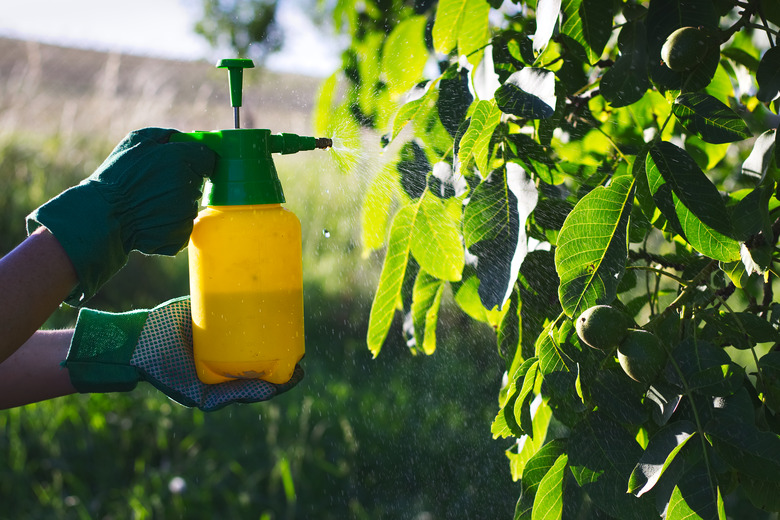10 Common Causes And Sources Of Indoor Air Pollution
While air pollution calls to mind factories and plumes of car exhaust, common household substances affect the air we breathe as well. Indoor air pollution, caused by carpets, household chemicals or even furniture or building materials, may have detrimental health effects, especially for those with health risks like asthma or even allergies. The best way to cut down on potentially harmful indoor air pollution is to first become aware of it and then either open the windows for some fresh air when necessary or swap out the common offenders for their more eco-friendly counterparts.
1. Common Household Cleaning Products
1. Common Household Cleaning Products
Modern household products, such as oven cleaners and disinfectants, make chores a bit easier but not without cost. Many products, such as bathroom tile cleaners, furniture polish and even air-freshening sprays, contain chemicals and even carcinogens that may be harmful. While the list of potentially harmful chemicals is practically endless, one good way to tell is if the product label says to use the product in a well-ventilated area or to avoid contact with skin.
If the product smells strong enough that you naturally want to open the windows when using it, this is another good indicator that it's a pollutant. Chlorine bleach is notably dangerous, as its vapors react with other common indoor gases to create volatile organic compounds (VOCs) and secondary organic aerosols (SOAs) that could cause headaches or eye, nose and throat irritation among other health issues. If you do use bleach or similar strong-smelling chemicals, always open windows first and let the room air out as long as is necessary. Stay out of the room for a while after using the product.
2. Dust and Pet Dander
2. Dust and Pet Dander
Dust is one of those things that seems to materialize out of nowhere no matter how often you clean. While it seems fairly harmless, it is one of the biggest sources of indoor air pollution. Dust contains dead skin cells, insect bits, pet dander, fabric particles and all sorts of chemicals plus dust mites and dust mite feces. For anyone with asthma or allergies, dust is problematic, as it can be virtually anywhere in the home. Dust mites thrive on pillows and bedding due to warmth and moisture, so it's a good idea to leave the bed unmade for a few hours after waking up.
To reduce dust, dust mites and pet dander, dust as often as possible, remove carpets in bedrooms in particular and swap upholstered furniture for leather, vinyl or wood, which doesn't collect quite as much dust. Use dust-blocking mattress covers. Air purifiers that remove dust and air contaminants are a huge help in bedrooms and any room that seems to collect an abundance of dust. (A bonus? Many air purifiers can also let you know when you have air quality problems in your home.)
3. Harmful Off-gassing Chemicals
3. Harmful Off-gassing Chemicals
Off-gassing happens when chemicals contained in an item are released into the air. For example, a new foam mattress is usually sealed in plastic at the factory, but once you open it at home, chemicals, such as toluene, escape into the air. For best results, let the mattress sit in a room with open windows for several days or for as long as is recommended by the manufacturer before covering it with bedding and sleeping on it. Flip the mattress after a day or so or stand it on one end to allow the chemicals to off-gas as much as possible before you use it.
Plywood, particleboard and pressed wood furniture and paneling also off-gas harmful chemicals, particularly formaldehyde. Exposure to formaldehyde can cause irritation to the eyes, nose or throat; headaches; dizziness; and with long-term exposure, even cancer. If possible, leave such items out of their packaging in a garage or even on a porch for at least several days or until odors subside before bringing them indoors. As an alternative, purchase products marked as low VOC instead. Buying floor models of such furniture is another option since these items have already lost most of their harmful gases.
4. Carpets and Upholstery
4. Carpets and Upholstery
Carpets and upholstery are well-known magnets for pet hair, dander and dust, but some also emit harmful chemicals into the air, especially when new. Many carpets sold in the United States contain toxins linked to hormone disruption, respiratory diseases and developmental issues. In some cases, carpet padding, carpet backing and adhesives are the main culprits. Adhesives often off-gas so much that the room should be aired out for several days before the newly carpeted space is used.
Opt for hard flooring to eliminate the kinds of chemicals found in carpeting. Hard floor surfaces are also a lot easier to clean and are less likely to trap dust, pet fur and pet dander. If you already have carpeting and plan to keep it, vacuum it regularly with a high-efficiency particulate air filtered vacuum cleaner, which removes particulate matter, such as dust and mites.
Many upholstered furnishings are treated with flame retardants or stain-proofing chemicals. While these options sound like a good idea, they're often full of harmful chemicals linked to cancer and other health problems. Read furniture labels before purchasing and opt for products that aren't treated with such chemicals. Some labels also indicate that the furniture meets safety standards for low chemical emissions; these labels vary depending on which organization's standards are met.
5. Paraffin Candle Problems
5. Paraffin Candle Problems
Most candles, unless otherwise indicated, are made from paraffin, which is a petroleum byproduct. When burning, the wick and paraffin emit soot and toxins, such as toluene, as well as fine particulate matter that floats in the air. All of these pollute the air a bit, which is especially troublesome for those with asthma or other respiratory issues. Candles scented with artificial fragrances add even more potentially harmful chemicals to the air.
As a safer alternative, switch to beeswax candles with cotton wicks or soy wax candles. These don't emit the same type of smoke as paraffin and do not contain VOCs. If you enjoy candles just for the look of them, battery-operated faux candles offer a similar flickering appearance without any smoke or fumes whatsoever.
6. Common Sources of Smoke
6. Common Sources of Smoke
Where there's smoke, there's air pollution, even indoors. Tobacco smoke, the fireplace and cooking food are all sources that add indoor air pollutants to your home. Smoking tobacco indoors releases all kinds of harmful chemicals into the air both when you exhale and when a lit cigarette sits in an ashtray (and we probably don't need to school you on all the dangers of secondhand smoke). These chemicals don't just vanish when someone finishes the cigarette. If you've ever visited a smoker's home, you're familiar with the odor of stale smoke, which is a buildup of all kinds of chemicals stuck to everything, from the furniture to the flooring and even the walls.
Wood stoves and fireplaces also emit smoke, fine particles and quite a few chemicals into the air, such as carbon monoxide. Gas fireplaces and stoves emit carbon dioxide but far fewer other chemicals in comparison to wood. A gas-burning fireplace can be dangerous if it isn't vented properly, and either a gas stove or fireplace, if it is releasing gas that isn't burning off, can cause a dangerous buildup of gas in the home.
Cooking certain foods also emits substances and chemicals into the air, even if you are cooking on an electric stove. At high temperatures, cooking oils, grease, fats and other elements in the food emit fumes into the air. Whenever there's an odor from cooking, gases and fine particles also linger. These all affect indoor air quality. To cut down on such issues, ensure that fireplaces and stoves are properly ventilated. Use the fan on a range hood, especially when cooking with high heat, or open windows if possible.
7. Moisture and Mold
7. Moisture and Mold
Too much moisture lingering in a room for a while could lead to mold, which could aggravate the airways, especially for those with asthma, allergies or respiratory infections. Although not very common in a home, some types of mold also contain toxins. If a room smells musty, there's a good chance of finding mildew or mold. Steamy, unventilated bathrooms, floods or a leaky roof are common sources of indoor mold.
Humid environments are particularly susceptible to mold. Always use a fan or open windows during and after shower use and be cautious about when and if you choose to run a humidifier. Running a dehumidifier or air conditioner reduces humidity, which helps reduce the chance of mold growth. If your basement is regularly damp, especially during rainy times, run a dehumidifier and empty it when it's full. Inspect and repair a roof if any evidence of a leak is visible indoors, such as ceiling water damage that is not caused by a plumbing leak. Plumbing problems should be repaired as soon as possible to prevent mold growth and damage to your home.
8. Pollen and Outdoor Allergens
8. Pollen and Outdoor Allergens
Pollen and other sources of outdoor air pollution sometimes make their way inside, which can be problematic if anyone in your home has allergies. Windows, intake fans and even an air conditioner could allow allergens into the home. Spending time in the outdoor air often means that allergens come indoors with you on your clothing or shoes. To help keep outdoor allergens outside where they belong, take off your shoes before entering the house. If you've worked in the yard when allergens are abundant outside, change your clothes, shake out the outdoor clothing outside and then wash the clothing.
If you're sensitive to outdoor allergens, keep windows closed when allergens are abundant. If you run an air conditioner, make sure the filters are changed regularly. Run an air cleaner that removes pollen and other allergens, especially in rooms where you spend the most time.
9. Pesticides and Foggers
9. Pesticides and Foggers
Any building that's home to people is also home to a pest or two, at least sometimes. When minor pests become major infestations, as may happen with termites, roaches or fleas, pesticides seem like the logical, expedient way to solve the issue. Unfortunately, many chemicals strong enough to kill insects are also harmful to humans and pets. Even if you've used a pesticide in one specific location in a home, the gases and particles in the pesticide linger in the air, finding their way into other areas of your home. Pesticides used outdoors could travel indoors on shoes and clothing or through open windows.
Foggers are even more potent. Being in the room during their use could cause immediate eye, nose and throat irritation as well as dizziness and headaches. If using a fogger or bug bomb, always use the size recommended for the treatment area and closely follow directions. Air out the home afterward and stay away as long as is recommended on the product label. With any type of pesticide, thoroughly clean any items that may have been exposed to the chemicals before using them. This includes countertops and dishware. It's a good idea to thoroughly wash the floor after bug bombs or foggers are used, as the fine particles in the air eventually land on surfaces in the room.
10. Aerosols
10. Aerosols
Aerosols negatively affect indoor air quality. Everything from hairspray to spray paint and even aerosol air fresheners may contain VOCs and other toxins, such as formaldehyde. Spray cleaners designed to solve one problem, such as getting rid of mold or mildew, may introduce other harmful chemicals into the air. Whenever possible, skip aerosols and choose low-VOC products instead. If you do use an aerosol, only do so in a well-ventilated space. Leave the room for a while after using the product.
References
- American Lung Association: Cleaning Supplies and Household Chemicals
- Camfil: Cleaning With Bleach is Bad for Indoor Air Quality IAQ
- Molekule: Off-gassing and Outgassing: What's the Difference and Where Is It From?
- Minnesota Department of Health: Formaldehyde in Your Home
- Asthma and Allergy Foundation of America: Why Healthy Indoor Air Quality is Important
- Environmental Working Group: Upholstered Furniture
- American Lung Association: Carpets
- Center for Environmental Health: New Report Finds Toxic Substances in Every Major US Carpet Tested
- Optimum Technologies: The Problems With Dry Adhesives or Wet Glue for Carpet Installations
- Washington State Department of Health: Foggers
- Enviroklenz: Are Candles Toxic to Indoor Air Quality?
- Golden Rule: A Surprising Wintertime Threat to Your Indoor Air Quality
- California Air Resources Board: Indoor Air Pollution from Cooking
- Centers for Disease Control and Prevention: Basic Facts about Mold and Dampness



